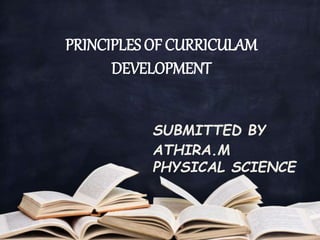
Curriculam
- 1. PRINCIPLES OF CURRICULAM DEVELOPMENT SUBMITTED BY ATHIRA.M PHYSICAL SCIENCE
- 2. The word "curriculum" began as a Latin word currere which means "a race" or "the course of a race”. It is broadly defined as the totality of student experiences that occur in the educational process. The curriculum in a literal sense ,a pathway towards a goal. CURRICULUM
- 3. Curriculum is actually what happens during a course i.e., lecture , demonstrations, field visits, the work with the client and so on. Curriculum also means a written description of what happens. Curriculum is an important element of education. Aims of education are reflected in the curriculum. In other words, the curriculum is determined by the aims of life and society.
- 4. Principles of curriculum construction Principles of Curriculum Construction are: 1. Principles of Child Centredness 2. Principle of Community Centredness 3. Principle of Activity Centredness 4. Principle of Variety 5. Principle of Integration
- 5. 6. Principle of Conservation 7. Principle of Creativity 8. Principle of Forward Looking 9. Principle of Flexibility 10. Principle of Balance 11. Principle of Utility
- 6. As modern education is child-centred the curriculum should also be child-centred. It should be based on the child's needs, interests, abilities, aptitude, age level and circumstances. The child should be central figure in any scheme of curriculum construction. In fact, curriculum is meant to bring about the development of the child in the desired direction so that he is able to adjust well in life. 1. Principles of Child Centredness
- 7. 2. Principle of Community Centredness A child is living in the community. If that child should become a useful member of the community he should first understand the needs of the community and try to solve them in a systematic way. Besides the society is ever changing. The child should be in a position to face the challenges posed by the community with efficiency.
- 8. 3. Principle of Activity Centredness The curriculum should centre round the multi various activities of pupils. It should provide well selected activities according to the general interests and developmental stages of children. It should provide constructive, creative and project activities. The purposeful activities both in the class- room and outside the class-room should be provided. It is through a network of activities that the desired experiences can be provided and consequently desirable behavioural changes can be brought about in children.
- 9. The curriculum should be broad-based so as to accommodate the needs of varied categories of pupils, so that they are able to take up subjects and participate in activities according their capacities and interests. The needs of pupils also change from place to place. For example, the pupils in rural areas, urban areas, and hilly areas will have different needs. The needs of boys and girls are also different. So these considerations should be reflected in the curriculum. 4. Principle of Variety
- 10. 5. Principle of Integration The pupils are to be provided with selected experiences through various subjects and activities but these must be well integrated. Various subjects and activities have to serve the same ultimate purpose, the achievement of the aims of education. The activities and subjects should not be put in after-tight compartments but these should be inter-related and well integrated so as to develop the whole child.
- 11. 6. Principle of Conservation One of the main functions of education is to preserve and transmit our cultural heritage. This is essential for human progress. Culture consists of traditions, customs, attitudes, skills, conduct, values and knowledge. However, the curriculum framers must make a suitable selection of the elements of culture, keeping n view their educational value and the developmental stage of pupils.
- 12. 7. Principle of Creativity Curriculum should have provisions to develop the creativity of children. Once this is developed, they can utilize this creativity which enables them to modify the environment according to their needs.
- 13. 8. Principle of Forward Looking Education is to enable the child to lead a successful social life. So the curriculum should not cater to the present needs of the child alone. The needs of his future life should also be considered. The curriculum should also include knowledge, skills, experiences, influences etc. which will develop in the child abilities and power to make effective adjustments in the later life.
- 14. 9. Principle of Flexibility In our age, rapid developments are taking place in various fields. Consequently the needs of society are hanging. The content of curriculum cannot be same for all times to come. It should not be static. It must be dynamic and change with the changing times. It should reflect the latest trends in the field of education and psychology.
- 15. 10. Principle of Balance The curriculum must maintain a balance between subjects and activities, between direct and indirect experiences, between academic and vocational education, between compulsory and optional subjects, between formal and informal education, between individual and social aims of education etc.
- 16. 11. Principle of Utility Curriculum should be useful rather than ornamental. It should not only include subjects which owe their place in it to tradition. The curriculum must have practical utility for students. So there should be some provision for technical and vocational education in the curriculum.